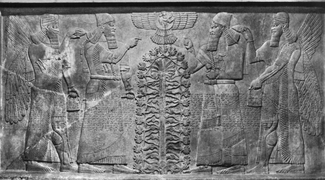Text and Image: Transmedial Inquiries into Ancient Near Eastern Cultures
This article first appeared in ISAW Newsletter 20 (Winter 2018).
Conference organized by Beate Pongratz-Leisten (ISAW)
April 27
 Wall Relief from the Throne Room in Ashurnasirpal II’s Northwest Palace at Nimrud
In the ancient Near East many monuments and artifacts incorporated both pictorial and written compositions. "Text and Image" has long been a trope in philological and art historical studies inquiring into the mixture or conjoining of the verbal and the visual. Image and language, and discourse and icon, are disjunctive symbolic systems, and there are sense-making operations that do not necessarily take a narrative form. Moreover, when it comes to narrative, it has been long recognized that the migration of a story or message from one medium to another presents cognitive consequences, and that the narrative potential will necessarily be differently actualized. Rather than perceiving of narrative as a linguistic object, this workshop examines narrative in cognitive terms, understanding it in the first place as a mental image recognizable in various media. The papers of this workshop will look at the strategies deployed in the construction of narrative, verbal and pictorial; the interface between the pictorial, myth, and ritual; the glorification of the rulership through text and image, and how the interplay between these intensified the intersection with the divine; the autonomy of the visual in ancient Near Eastern art; and techniques of writing and drawing on clay, which required the scholarly professions to develop artistic skills.
Wall Relief from the Throne Room in Ashurnasirpal II’s Northwest Palace at Nimrud
In the ancient Near East many monuments and artifacts incorporated both pictorial and written compositions. "Text and Image" has long been a trope in philological and art historical studies inquiring into the mixture or conjoining of the verbal and the visual. Image and language, and discourse and icon, are disjunctive symbolic systems, and there are sense-making operations that do not necessarily take a narrative form. Moreover, when it comes to narrative, it has been long recognized that the migration of a story or message from one medium to another presents cognitive consequences, and that the narrative potential will necessarily be differently actualized. Rather than perceiving of narrative as a linguistic object, this workshop examines narrative in cognitive terms, understanding it in the first place as a mental image recognizable in various media. The papers of this workshop will look at the strategies deployed in the construction of narrative, verbal and pictorial; the interface between the pictorial, myth, and ritual; the glorification of the rulership through text and image, and how the interplay between these intensified the intersection with the divine; the autonomy of the visual in ancient Near Eastern art; and techniques of writing and drawing on clay, which required the scholarly professions to develop artistic skills.